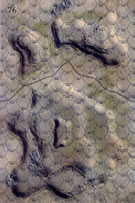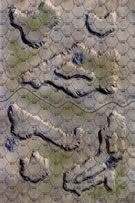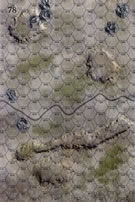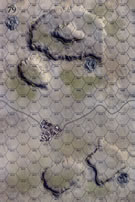|
Hightower's Attack An Army at Dawn #23 |
||
|---|---|---|
| (Attacker) Germany | vs | United States (Defender) |
| Formations Involved | ||
|---|---|---|
| Germany |  |
10th Panzer Division |
| United States |  |
1st "Old Ironsides" Armored Division |

| Total | |
|---|---|
| Side 1 | 5 |
| Draw | 0 |
| Side 2 | 1 |
| Overall Rating, 7 votes |
|---|
|
3.57
|
| Scenario Rank: 365 of 913 |
| Parent Game | An Army at Dawn |
|---|---|
| Historicity | Historical |
| Date | 1943-02-14 |
| Start Time | 09:00 |
| Turn Count | 24 |
| Visibility | Day |
| Counters | 167 |
| Net Morale | 1 |
| Net Initiative | 2 |
| Maps | 4: 76, 77, 78, 79 |
| Layout Dimensions | 86 x 56 cm 34 x 22 in |
| Play Bounty | 181 |
| AAR Bounty | 165 |
| Total Plays | 6 |
| Total AARs | 2 |
| Battle Types |
|---|
| Exit the Battle Area |
| Hill Control |
| Inflict Enemy Casualties |
| Urban Assault |
| Conditions |
|---|
| Minefields |
| Off-board Artillery |
| Randomly-drawn Aircraft |
| Reinforcements |
| Smoke |
| Terrain Mods |
| Scenario Requirements & Playability | |
|---|---|
| An Army at Dawn | Base Game |
| Introduction |
|---|
|
Once again II Corps bypassed 1st Armored Division’s commander and arranged the American defenses down to company level. Fredendall and his staff considered Djebels Lessouda and Ksiara the keys to defending Sidi Bou Zid but they were too far apart to control the ground between them or offer protection to each other. This necessitated sending tanks forward each morning with orders to send up a flare in case of an attack. Artillery would then fire on predetermined coordinates to slow the attackers while Lt. Colonel Louis V. Hightower’s 3rd Battalion of the 1st Armored Regiment advanced to meet the intruders. |
| Conclusion |
|---|
|
Things didn’t go right from the beginning for the Americans, as the forward tank commander overslept and did not fire a flare when the Germans made their move. The Wehrmacht soldiers quickly isolated the Americans on Djebel Lessouda and left them for later. As they began to swing south Colonel Louis V. Hightower received orders, as planned, “to clear up the situation.” He found his tanks outnumbered and outgunned, and quickly retreated back to Sidi Bou Zid with just a dozen tanks, leaving the rest to cover the supply train’s retreat. The armored force suffered heavily with only seven of the battalion’s 52 Shermans surviving the day. However, they did extract a toll on the enemy while the supply train slipped safely away and Combat Command A’s headquarters moved. |
| AFV Rules Pertaining to this Scenario's Order of Battle |
|---|
|
| 5 Errata Items | |
|---|---|

|
The reduced direct fire value of the Heer HMG became 5-5 starting with Fall of France. (plloyd1010
on 2015 Jul 31)
|

|
All SS PzIVH tanks should have a movement of 8. (Shad
on 2010 Dec 15)
|

|
The morale and combat modifiers of German Sergeant #1614 should be "0", not "8". (Shad
on 2010 Dec 15)
|

|
All SPW 251s have an armor value of 0. (Shad
on 2010 Dec 15)
|

|
Liberation 1944's Tiger movement and armor ratings are backwards. They should be Armor 7 and Movement 5. (petermc
on 2014 Feb 14)
|
| An Army At Dawn, scenario #23: Hightower’s Attack | ||||||||||||
|---|---|---|---|---|---|---|---|---|---|---|---|---|
An Army At Dawn, scenario #23: Hightower’s Attack Besides watching a fantastic World Cup final game today, I played this scenario. The Americans start with three forces on the four maps including a smaller one that starts on map 78 with minefields protecting them but with no victory objectives, so I ended up during game play having them relocate to map 77 to try and protect some 40-meter hills. They also have a fourth battlegroup that enters later but didn’t arrive until turn 7. The Germans have two forces, one that enters on turn 1 and a reinforcement battlegroup that entered on turn 4. There are many interesting victory objectives, so neither side can focus one but a big chunk are on map 76 and the Djebel Lessouda hills and also the town of Poste de Lessouda and a number of other victory objectives not to mention eliminating enemy steps. The Germans also control the airspace and get to pound some American positions with their air-force. The Germans are on the offensive and their initial Reimann Battle Group slits into two groups, with one heading for the town of Poste de Lessouda including the Tiger Tank units, while the other half heads north for the hills of Djebel Lessouda. The German easily destroyed a small group of Americans defending in the town hexes on map 79 but the group that went north really took some heavy loses and I started to think a made a big mistake but fortunately for them their Gerhardt Battle Group arrive early and attacked the Americans on the Djebel Lessouda hills from the north, which had focused their attention to the Germans attacking them from the south, sandwiching them in the middle. In the South the German decided to ambush the American reinforcing 1st Armor Combat Group with Tiger Tanks and 88mm Anti-Tank Guns as this harvested more points for them than exiting units off the south edge of map 77. The ploy worked very well, the American armor suffered heavy casualties. I pulled the plug on this scenario a bit early, as adding up the points, the Germans had 81 and the Americans had 47 giving the Germans a Major Victory. The situation at this time, would only have given the Germans more points. With that said, it was a very fun scenario to play, deciding what strategies to use and what objectives to go after, for both defender and attacker. A nice mix of unit types to fight it out over 4 maps. Tigers are still king of the Battlefield and I would of hated to be in a Stuart or Sherman tank when facing them. |
||||||||||||
| 0 Comments |
| Try to Hold the Town and Djebel Lessouda! | ||||||||||||||
|---|---|---|---|---|---|---|---|---|---|---|---|---|---|---|
This was a fun-filled & action-packed 11-session play-through with the hard-hitting & well-organized, T-Rex leading attacking elements of the German 10th Panzer Division. I led defending elements of the US Combat Command A of the 1st Armored Division in this large-scale, 24-turn, combined arms fracas. Both sides drew excellent sets of leaders. We played with the FOW (beginning on game turn 12), consolidation, smoke/illum, extended assault and excess initiative optional rules. In addition, we used the following four house rules: 1) Road Movement for Mechanized & Foot Units All FOOT & MECHANIZED units may move on roads at the rate of 1/2 a Movement Point (MP) per road hex, just like MOTORIZED units 2) Standardized Movement for Mechanized Units All mechanized units may move through clear hexes at a movement cost of only 1 movement point (MP) per hex, instead of 1 1/2. Add one to this cost if moving up or down slopes hexes. 3) Dug In Units on Slope Hexes are Automatically in Limiting Terrain in Desert Games Unless prohibited by special scenario rules, ALL units that are dug-in on slope hexes are considered to be in limiting terrain and are spotted if enemy units approach to within 3 hexes, or 4 hexes for reconnaissance units – unless they are marked with a spotted marker, see 8.22. 4) Tank Leader Forward Observation Full strength, efficient tank leaders may spot for ALL artillery & air strikes in accordance with the normal spotting rules (8.0, page 19). Just as leader units may spot, this action does not require an activation. This set of rules worked out great on what turned out to be a major Axis victory that took a very long time to complete The initial session (game turns 1-3) featured a well-designed & flawlessly executed, German movement-to-contact in the southern half of Map 79. Apart from some very lucky US OBA strikes and a Landser platoon being destroyed in a 3-strength minefield, the combined arms Axis force was able to find, pin, isolate and flank the near-helpless US garrison in Poste de Lessouda by the end of game turn 3. Step losses totaled, 2 for the green American defenders; and only 4 steps, and a Sergeant for the Germans. The victory point tally was: 38 for the US, and 2 for the surging German side. A combined FIVE combat 7-die rolls were thrown. Our frustrating second session (game turns 4-5) featured continued the tightening of the German grip on the battle field and the first capture of a hex in Poste de Lessouda, after the German engineers clambered through a minefield under ineffective Allied bombardment fire! A single step of the US infantry garrison was eliminated, and a successful Luftwaffe air strike disrupted the sole US 75mm pack howitzer on the upper reaches of Djebel Lessouda. The heavy German armored spearhead with accompanying infantry formations continued moving west on the trail, through the main east-west high speed corridor. The third session (game turns 6-7) was the beginning of an extended cat & mouse component in which Hightower’s American armored battalion entered from the south edge of Map 79 and took up hilltop overwatch positions south of the now-occupied, 3-hex Poste de Lessouda town. A smattering of American OBA mostly fell ineffectively here and there, and more effective German OBA disrupted the only US 105mm platoon in the rocky area on the 40-meter north-south trending hill mass on Map 78. As happened historically, a platoon of US Stuart tanks was eliminated on the move by accurate, long-range AT fire by a platoon of Tiger tanks. A section of German combat engineers was also eliminated. The updated step loss tally was now: 8 for the Americans, and a mere 7 for the advancing Germans. Probing German columns made good their previous advances to higher ground on Map 77 by digging in on both hill crests. The overall victory point totals were: 33 for the rapidly diminishing US side, and 16 for the surging Germans Our very frustrating, but entertaining, fourth session (game turns 8-11) was characterized by: 1) a lengthy exchange of ineffective, long-range AT fire; 2) apart from one German OBA success, some equally ineffective artillery & air strikes; and 3) an American AT gun platoon was lost to massed infantry fire; and finally, 4) a sacrificial US halftrack was eliminated in a hilltop close assault. The step loss tally was now: 11 for the GIs – resulting in an initiative decline to 1 for the US side; and still a mere 7 for the advancing Germans. Thankfully, only a combined, THREE combat 7-die rolls were thrown this session. The high-casualty & maneuver-heavy, fifth session (game turns 12-13 ) featured: 1) the dramatic entry of German Battle Group Gerhardt on the north edge of Map 78 who were rapidly engaged be a handful of American armored platoons, resulting in the loss of four SPW platoons & two leaders on scouting missions; 2) a prolonged exchange of AT fire at variable ranges resulting in the destruction of a pair of US tank destroyer units and 2 steps of German tanks on map 79; 3) a very lucky American OBA strike in Poste de Lessouda that eliminated a step of Jerry engineers; 4) effective use of smoke screens by both sides, and 5) the elimination of the second platoon of American Stuart tanks. The updated casualty tally had become: 19 steps for the GIs – resulting in an initiative decline to zero for the US side; and 15 steps, PLUS an initiative decline for probing & surging Germans. A combined, SEVEN combat 7-die rolls were thrown this session Our sixth session (game turn 14) featured the onrushing, combined arms, Axis tide inexorably moving south on Map 78, taking advantage of the low hill and east-west wadi. Their armor began to swing west as they approached the east west trail. This session was less costly for both sides with the Germans only losing a scouting SPW platoon, a Grille SPH unit, as well as a leader, while the Americans lost a section of dug-in, Sherman tanks. The casualty totals were now: 21 steps for the Americans; and 19 steps for the advancing Germans. As before, a combined, FIVE combat 7-die rolls were thrown – mostly be the Americans – this session. The seventh session (game turn 15) featured the development of a very strong, all armor, German, right flank thrust south on the western margins of Map 78. Three steps of US armor were destroyed in-place on the westernmost 20-meter hill by very effective overwatch AT fire, that was eventuated by a 4-activation, initiative roll set to start this game turn. An eager Pz-II platoon that was leading this thrust was eliminated by accurate US long-range armor piercing shots. The American, combined arms counter attack on the northernmost, 20-meter hill on Map 78 gained strength, and caused the bulk of the Axis infantry units to pause and reverse course in response. This likely means that the bulk of the Battle Group Gerhardt’s infantry will not be able to cross the map and exit the south edge of Map 77 by the end of the scenario. The step lost tally was now: 27 steps for the Americans; and 24 steps for the steadily-advancing Germans. As before, a combined, FIVE combat 7-die rolls were thrown this session Our eighth session (game turns 16-17) was a very grim one for the embattled American defenders with the loss of an additional 9 steps, to only a single step loss for the surging Germans. The Teutonic horde continued a pair of thrusts to the south across Map 78. In the northern sector, the Germans were held up by a hilltop close assault in hex 78-0514 resulting from a combined arms, American counterattack. On the western margins of Map 78, the 2-part, German tank movement south continued, though slowed by minefields and hilly terrain. The updated victory point tally was now: 50 for the Americans, and 43 for the Germans. A combined FIVE combat 7-die rolls were thrown in this session. The bloody, ninth session (game turn 18) was an unexpectedly grim one for the German side with 7 unanswered step losses including a decoy Pz-IIIH tank platoon in the SW corner of Map78. On the opposite corner of the same map, fierce, close assault fighting on the 20-meter hill continued with the surprising loss of 2 steps of Landser & pioneer infantry. The armor-heavy Teutonic right flank advance on the western map margin slowed & consolidated in between the US minefields, taking advantage of the low mesa to muster strength for their next bound. This was done in a manner to avoid American AT crossfire. On the southern plain surrounding Poste de Lessouda, a pair of Tiger I heavy tank platoons continued holding their positions to the north & northwest of the 3-hex town. Step losses by the end of the session were: 32 for the Germans, and 36 for the defending GIs, resulting in the Axis side losing a level of initiative. The victory point tally was now about: 57 for the Americans, and 46 for the still-advancing. Germans. Only a combined THREE combat 7-die rolls were thrown. Our tenth session (game turn 19) was a very costly episode for both sides with an additional 4 steps of armor lost by the Americans, and 8 steps of German troops, along with 4 leaders. This loss reduced the Jerry initiative by one level, while the American counter attack in the northeast quadrant of Map 78 succeeded in securing the 20-meter hill. Many positive morale rolls were recorded for the surging German side and some accurate AT fire drove a number of mobile US platoons out of their prepared positions. In all, a combined FIVE combat 7-die rolls were thrown, usually at inopportune moments. The advancing, right and left flank German columns continued to draw US units off their initial hill slope positions, and into the valleys on the western portions of the battle map. The updated victory point totals were now; 45 for the advancing Huns, and 63 for the embattled US defenders. Our brutal, final session (game turns 20-24) featured an unstoppable armored charge of the remaining German units that exited the south edge of Map 77, in the face of relatively feeble and easily pushed aside US defenders. The pair of slow-moving, but undamaged, Tiger I heavy tank platoons were the last of the Jerry armor to exit – they were worth 6 victory points! In all, there were only 6 FOW-shortened game turns in this Major Axis triumph. This was a fun-filled, maneuver-heavy, and very gamey scenario in which the Germans may simply: 1) take the 3-hex town of Poste de Lessouda; 2) control a handful of 60 and 40-meter hilltops on Map 77 & 76; 3) shoot up a quantity of US steps; and 4) sashay off the south edge of the battle map to win a major victory even with the paltry, 10 more victory points than the GIs might manage. This is relatively easy for the attacking 10th Panzer, as Hightower’s relatively weak and strung out force has relatively few, widely-scattered resources with which to even slow down and/or significantly delay the well-equipped, Teutonic Horde. As such, we recommend this one for SOLO play, and as a good learning scenario for combined arms maneuver. I give it a generous 2, because it was fun to play with a quick-witted & fast-moving opponent. My opponent thought that it merited a 3 in shared play. The four house rules we used, improved this scenario’s fun factor and simplified movement, enhanced armor piercing effectiveness and combat observation in the barren and hilly desert terrain. |
||||||||||||||
| 1 Comment |
This tremendous, online battle in 1943 Northern Tunisia is dedicated to the memory of the late Lt. Colonel Robert Trantin, Special Forces, USA (Retired) who passed away earlier today. A great PG opponent (Daedalus), father, husband, friend, combat leader, jolly foil - and an even better man.

 AAAD022
AAAD022 
















































